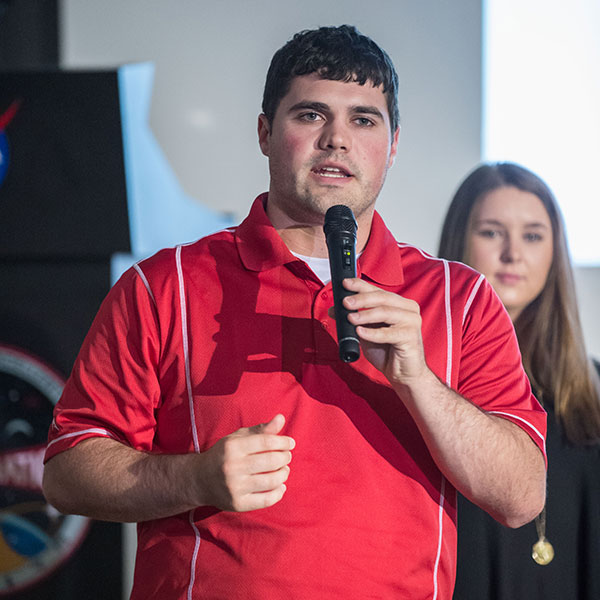Calendar Icon
Jul 15, 2016
Person Bust Icon
By Karl Vogel
![]() RSS
Submit a Story
RSS
Submit a Story

Designing a gap-spanner boom that would connect NASA's Orion space vehicle with the Asteroid Retrieval Vehicle and allow astronauts to traverse between the two was tough enough.
For the UNL Air and Space Research Team, the typical design process proved to be an unusual challenge that may set the team up for more successes in years to come.
Team leader and lead designer Luke Monhollon, a senior biological systems engineering major, was one of two member of the team that were part of the 2015 crew that traveled to NASA’s Johnson Space Center in Houston, Texas, for the Micro-g NExT program. Monhollon’s experience would be vital to the most-recent team, but would have to come from seemingly light years away as he spent the spring semester as a NASA intern at the Kennedy Space Center in Florida.
The space between Monhollon and the rest of the group caused the ASR team to find novel ways to communicate.
“It was a bit of a monkey wrench,” said Carl Nelson, professor of mechanical and materials engineering and the ASR faculty adviser. “There’s nothing like face-to-face communication, but we weren’t able to do that. There was a fluidity and connectedness that was missing. Mostly, we just found ways to get through it and it worked.”
That included taking cell-phone photos of design sketches and sending them back and forth between teammates and conducting weekly team meetings via webcam.
As lead designer, Monhollon instituted “mini-meetings” via phone or webcam with one or two other team members to keep the design process on track, which he said helped to bring more team members into the process.
“Typically, the first year you’re on the design team, you don’t contribute much because you don’t know the right questions to ask,” Monhollon said. “This year, keeping it one-on-one, it really brought up the freshmen and the new people on the team and they really stepped forward.”
Settling on an expanding, scissors-like design proved to be popular with the NASA engineers, who host the annual event to find novel ideas to solve problems for actual space missions.
Getting to that point, though, was not a smooth process, Monhollon said.
“Other teams pick the most obvious solutions. Our team is very well known for doing interesting designs and focusing on different aspects,” Monhollon said. “Last year, our original design was a pretty standard one, then we all looked at each other and said ‘No.’
“I anticipated that was going to happen this year. The obvious path would be a telescoping design, and most of the other teams in our category did that. We thought of that, but I said, ‘You have to pick something else.’ There was a little pushback, but what came through was something really interesting to look at and really sparked ideas.”
The ASR team members in Lincoln built the prototype, which Monhollon didn’t see in person until three weeks before the trip to Houston.
At the Johnson Space Center, the team – Monhollon, Claire Ashley, Nathan Borcyk, Brandon Jackson and Allison Porter – put on a 15-minute presentation for NASA engineers and then guided divers who tested the device in the Neutral Buoyancy Laboratory’s massive pool that is used to simulate conditions in outer space. Porter is working as an intern at Johnson Space Center this summer.
Nelson said the feedback received left the ASR team members feeling “pumped.”
“The engineers were fighting for the chance to be the first to try it out,” Nelson said. “After the presentation, there’s a to-do list of things to make the device fit NASA standards – file down sharp edges and remove safety risks. Usually, teams have two or three things they have to do before it can be tested in the pool. We had none at the end.”
Monhollon said keeping things simple, in the design process and with the operation of the boom, paid off in the evaluation.
“They’re always looking for new ideas (at NASA). That’s one of the reasons our design was so successful is because it is not typically seen,” Monhollon said. “It was complex, but it wasn’t complicated. We split those two somehow. It required very little input from the diver to actually know how to utilize the tool.”
Monhollon said the success of the design was in part due to the diverse makeup of the team – with students pulled from biological systems engineering, mechanical engineering, electrical engineering and chemical engineering.
“If you have only mechanical people, they all tend to work the same and think the same and have the same jargon. When you’re on a multidisciplinary team, you have different people with different skill sets and you start leveraging them and developing the communication, how to speak between different people,” said Monhollon, who will spend the fall semester as an intern at the Johnson Space Center.
“Next year, we’re looking at expanding the team to include business and education majors and making the group even more diverse.”
Submit a Story





